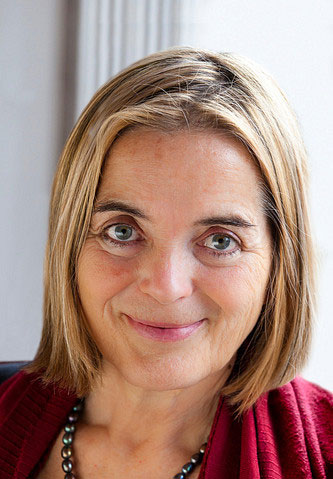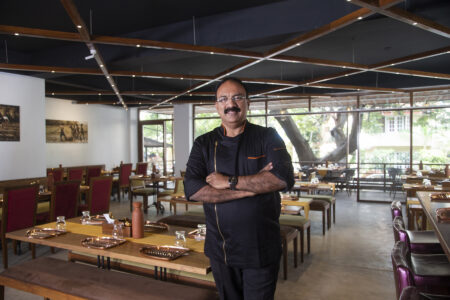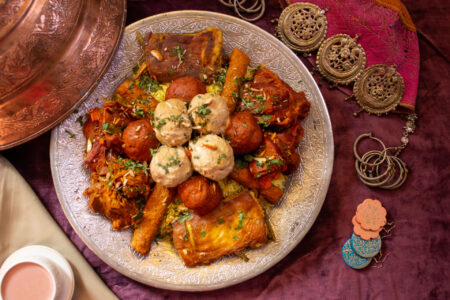Naomi Duguid’s gorgeous new book, Taste of Persia: A Cook’s Travels Through Armenia, Azerbaijan, Georgia, Iran, and Kurdistan, has just won a James Beard Foundation award. A traveller, writer and photographer who has co-authored six books with Jeffrey Alford, two of which have received James Beard Cookbook of the Year Awards, Duguid is a cookery teacher who leads culinary tours through Burma and Northern Thailand, and her previous book, Burma: Rivers of Flavor won the IACP Cookbook award for Culinary Travel, 2013.
Kaveri Ponnapa met Naomi Duguid at the Goa Arts and Literature Festival, where they spoke on Food and Identity. Kaveri later had an extended conversation with the author about her life spent travelling the world, understanding people and cultures through their food, and sharing the entire experience. Duguid’s are rare cookbooks –part travelogues, photographic essays and culinary records, woven together with stories of ordinary human affairs and framed by her acute observations on people and cultures.
– Did mapping and documenting food grow out of a love of travel, or was it the other way around?
It came out of curiosity. If I am somewhere else, I want to understand ‘there’. What appeals to me is the way people think about their lives or their living, the way human beings engage with their environment. The most available way to begin to have some small understanding about this is through food. Eating food is a shared thing, so I can be, in some very small way, a participant when I eat the same food as you are eating. Then when I come home and translate the version of the dish I had, I come to a further understanding and appreciation of the creativity of the cooks who made the original dish. It starts with wanting to understand how people live. Food is a very creative art. People outside the industrialized world put in an enormous amount of effort, calories and energy into the growing and production of food. That is human survival and I don’t think there can be anything more interesting.
– It is not easy to categorize your books- they are photo journals, memoirs, cookbooks, travel diaries, cultural documentaries all in one, where, as you have put it, food as a recipe is not really the point, but the cultural context is. How did this style evolve?
We had to work quite hard. Our first book was about a topic that nobody thought was interesting. We were lucky to get published. It was lucky that there was a publisher interested in travel stories about guys with guns in Yemen or stories of a train journey in Georgia! I did not set out to write a cookbook, I set out to understand. The context gives the understanding. The detail is the specific recipe. Only when the recipe appears in its context, suddenly, it glows. You can appreciate the recipe because you appreciate the context. Flatbreads and Flavors has just 60 bread recipes –they are contextualized within other recipes. Bread is the central thing, but it didn’t make sense to do a book about just breads. The flatbreads and their place in people’s day, in people’s hearts is what make us appreciate what they are. This relationship is the important thing.
-You have covered such a spread of cultures, people and geographical spaces. How do you connect with people? Go to the heart of things? How much is planned, and how much is luck and perseverance?
None of it is pre-arranged. That’s the best part. You need time. You need layers. You need to go back to the same place several times. The first time you think, ‘I have a bit of a grip here’. Then the next visit –next year, or maybe ten years later –things seem different; you see how they have changed, and that gives you an insight into what was going on the first time, which you did not see then. Having time, not being rushed and just hanging around is important. It’s about not being needy –if you are in a hurry, you are already reducing your frame. It’s about being aware, open, just wanting to be available, not making assumptions –when you start making assumptions, you stop looking at things. You have to hope that you will be back a few times –then you can get rid of the superficial, the distractions of the first time traveller. Wedding foods, for instance, are other people’s interest –what I’m interested in is bread, or tortillas in Oaxaca, Mexico. At certain times in conversations with women they will realize that I’m completely ignorant and maybe one of them will have the ability to invite me to her house, saying “I’ll have to show you”. We, as home cooks, have this impulse to include people. I sometimes get swept up into somebody’s engagement with his or her own home cooking process. In Udaipur I was unbelievably lucky to have learnt how to build a tandoor oven from a woman who built them for a living. I asked if she would teach me and she agreed; they were comfortable having me in their household; I learnt so much, it was a great privilege.
– You last two books: Burma, Rivers of Flavor, and Taste of Persia have taken you to regions of political uncertainty and rigid control. How did you see this reflected in the way people cooked and ate?
In the kitchen, or behind the door, is a safer place than outside. There is a line between public and private, the safe zone and the place where you have to be cautious. In a totalitarian state, you have to be very cautious. Eating in private becomes special, extra precious. There is an extraordinary appreciation of private eating spaces and the safety of the household. When I went to Burma in the late 1990’s, at teashops, which have been public places of discussion and engagement, you would see only two people sitting together: if you have three, you have one person who can tell on the other two. There was a freezing of a sense of freedom. So, there are all these subtle things that go on. In Iran, the making, buying and consuming of alcohol was behind doors. It was illegal, but at the same time there was complicity, since everyone knew it was being done. The split between public and private becomes extreme.
– There are an astonishing number of very accessible recipes in your books. How did you go about first collecting, and then recreating them in your kitchen?
These recipes started out as a lived experience, in other words, eating something and then having it again; it’s a familiarity with a range, a variety. Or it starts with a conversation with several people about what they like or don’t like, what can be put into a dish and what cannot.
There’s a story about a Portuguese mountain rye bread in Home Baking. It’s wonderful bread, quite tricky to get right because of the simplicity of the ingredients. I was staying with somebody who made the bread, and we had it for supper with some local honey. The next day, I bought some of the honey to take back with me and when I baked the bread at home, I had the honey as my guideline to see how they went together. When you ask, what’s included and what’s not, I don’t include things that I might like, for example, but are difficult for people to take on. I am asking them to travel a long distance imaginatively in making a dish from the book. I like to use recipes that are going to work well, and things that are accessible. I want to give them confidence to try more recipes. In Rivers of FIavor I put warning flags – pungent/acquired taste, so that people would start with something simpler. I’m sure there are dishes that are wrong –someone may agree with my way of making them, some may not. For me, it’s important to remember I’m ignorant, I’m an outsider, of course there are going to be errors: but I have to try to navigate it, otherwise you’d never start.
– The home cook, working with limited resources and creativity and ingenuity has earned your respect. Please share a few experiences of home cooks who have impressed or moved you in the way they managed their kitchens and the food they cooked.
Generally, it’s a woman who is producing food three times a day, every day, for a family –it’s an extraordinary thing. It’s a management of money, work time, flow, supply and re-using leftovers. It’s an incredible management skill, as well as making something that the rest of the family will eat. I think about a woman I wrote about in the Seductions of Rice, in Senegal, cleaning and pounding millet and rice. Every day she was making different dishes, the food was delicious. But it was also about watching her manage her resources, making judgments about how much to make, spending 8-10 hours a day in food production.
The other person I can think of is someone I wrote about in Mangoesand Curry Leaves , in Kutch. She made a very simple potato curry and millet flatbread. She made one bread at a time; when I tried making a dough for two at home, it did not work. I realized that you have to make them from scratch; one at a time, and then nothing is wasted. Those skills, working within the limits of what you have and you don’t have and managing that every day –I think, hats off to home cooks everywhere. It’s a remarkable achievement and it’s unsung. They are the heroines.
– How do you learn by what you refer to as “watching and doing”? This is something we recognize, it is exactly how we learned how to cook in Indian homes until a generation ago. How do you share this with people who are part of your culinary tours in Thailand (Immerse Through)?
When I’m working on a book, I’m an ignorant outsider, watching, and I’m trying to understand gesture. I take photographs as a note taking. When I get home, and look at the photographs, I see things I did not consciously notice while I was there. Nobody is telling me here’s the recipe this is how it is done. I have to deduce, intuit, and feel my way into how the dish is made. In the Immerse Through course (http://www.immersethrough.com/) I don’t give people recipes. My Thai friend’s mother is the teacher for the first two days. She speaks no English, she teaches only by showing. My friend and I are the go-betweens. The students are often food professionals, and they have to find the body familiarity, they almost have to get it imprinted on their bodies by doing various tasks around the kitchen. After two days of work they sit down over a meal and go back over each recipe. Until then there is only a list of ingredients, rough quantities and techniques. They have to write out their own recipes. When they go back, they connect their physical and visual experiences. If I gave them the recipe first, they would be tied to it. A recipe should be guidance, it should be opening a new a door, and they should walk through the door by themselves.
– What was the one cuisine you knew best before you began to explore others?
Home cuisine was what I knew. My mother’s parents were English and French. I was raised with home cooking where my mother made her own marmalade and bread. She was a wonderful natural cook. Hers was excellent English country cooking, and French, too. Those were both already very familiar to me. We had friends who were English, but had spent a lot of time in Malaysia, so I ate Malay, Chinese and Indian food at their home before I went to the sub-continent. I had Chinese friends from Cambodia in France in the late ‘60’s, so food was always a doorway, but I never felt that I was mistress of any of it. My mother’s unselfconscious confidence in the kitchen was the model that I had. You don’t have to have exactly the right thing, you make food with whatever you happen to have available: un-formulaic cooking was what I was most familiar with.
– How have your travels changed the way you perceive food and the way you cook and eat at home?
I had the good luck of have been raised by a good cook; so, although we are eating different things now, I think I am eating in very much the same way, with the same attitude. I became a rice eater in my early 20’s –I was seduced by rice. I could eat rice three times a day, happily. For people who are not rice eaters, this is mysterious. That was a shift. Also, instead of eating plated food, I put out various things; I like to give people reasonable choices, being casual. It is very important for a cook not to feel rejected if the dish is not appreciated. You need to be generous minded about the food being served.
This article also appears in The Goya Journal, 1st May 2017
Image Credits:




